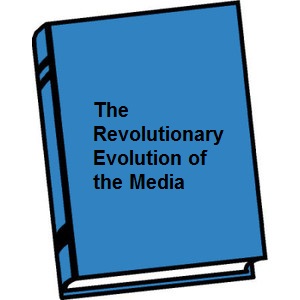“TREotM” – Propaganda and the Media

“The Revolutionary Evolution of the Media” -- Chapter 8, Part 6
This is a book in progress. Go here to read the previous chapters.
Is propaganda just a long dirty word?
Today, it seems so. But it wasn’t always just a negative. The word meant (and still means) propagating a message. Good or bad. Or, to put it another way, promotion, PR and/or advertising.
Propaganda per se goes back – as does much of civilization – to the early Greeks. Free men formed a government of sorts in Athens and “selling a message” of government provides us with one of the earliest examples of using propaganda for an end.
Governments of every structure and almost every geographical structure learned. Many then created their own departments of communications, information, official notices and so on. During the mess of the Spanish Armada, as noted before, the Spanish King Philip II and his enemy Queen Elizabeth of England engaged in rather vociferous manners to distribute misinformation. Even years later, Sir Walter Raleigh complained about a Spanish report of sea battle saying, “no marvel that the Spaniard should seek by false and slanderous pamphlets, advisoes, and letters, to cover their own loss and to derogate from others their own honors, especially in this fight being performed far off.”
Of course, it took the Church and Pope Gregory in 1622 to put a name on the growing idea of propaganda; he created the Congregation for the Propagation of Faith. It had control over missionary territories and related institutions. As a result of the missionary activity, the word propaganda came in wide use as the Church proselytized. Later, Pope Urban VIII created, while arguing with Galileo about heliocentrism, the College of Propaganda to train missionaries (he also loosened the exclusive Jesuit hold on missionary activities in certain countries allowing other orders to fan out around the world as well).
Later, as the U.S. evolved from a republican experiment into a functioning, the Federalists fretted over conditions in post French Revolution Europe. The Federalists, as Paul Starr writes in his Pulitzer Prize winning The Creation of the Media: Political Originations of Modern Communications, became “the party of conservative nationalism, unabashedly in favor of rule by the rich and the wise.” Not surprisingly, after the Jay Treaty with Britain that angered the French who then refused an American representative and began seizing American ships, the Federalists decided that anyone writing or speaking against them could not be tolerated.
So they went after a weak Republican press targeting the newspaper Aurora, edited by Benjamin Franklin Bache (a grandson of guess who) by having him arrested for seditious libel. A Supreme Court justice suggested that was out of bounds as no such law then existed. The Congress, acting like the one after 9/11 in this century, quickly introduced the first draft of the Sedition Act of 1798 making it a crime, “to write, print, utter or publish … any false scandalous or malicious writing or writings” against the government, the Congress or the President “with intent to defame.” It passed the Senate.
That was little much for the House from a group that, before the Constitution was ratified, had claimed the government would not and could not exercise power over the press. The resulting Sedition Act of 1798 (which passed the House 44-to-41) required proof of malice, truth as a defense and permitted grand juries to rule on the law as well as facts.
War, or as in 1798 the rumor of it, has a way of creating an overwhelming desire for control of information. In Britain in 1914, there was no mechanism for doing so. As nations entered the “war to end all wars” governments all across Europe moved quickly to take control of civil society and public opinion as well as economic life.
Woodrow Wilson had won the Presidency partly on the slogan “He Kept Us Out of War.” But by early 1917, that was clearly not going to be repeated. So, as Washington crept toward joining the total war overseas, the government began to worry, for good reason, about public opinion. Besides the drive to eliminate the German language and the demand for all to be “100% American,” the Congress moved to allow for the censorship of the press by the President and tighter controls on average Americans.
The US declared war and began operations on April 6, 1917. On June 15, Congress passed the Espionage Act after the House had made certain any direct mention of censoring the press was eliminated. But, deep in the bill, restrictions against interfering in any way with the US military and empowerment of the Postmaster General to deny distribution of certain writings turned the censors loose.
Earlier Supreme Court cases (Patterson v. Colorado in 1907) ruled the 1st Amendment only applied to prior restraint, that truth wasn’t a defense after the fact and that denying 2nd class postage to a publication was OK.
Then the Trading with the Enemy Act of October, 1917, gave the President authority to control all international communications and required foreign publications to submit English language version prior to any distribution. On top of that, Wilson created a Censorship Board in May of 1918 that required ALL publications to submit copies of any articles about the war or the government prior to distribution.
The war made clear how to destroy (open) dissent. Nationalistic fervor drove citizens of most every country in the war to new levels. In the US, Thomas W. Gregory, Attorney General and member of the Censorship Board, came close to officially inciting vigilantism when he said in November 1917, “May God have mercy on them [dissenters] for they need expect none from an outraged people and an avenging Government.”
That was made that abundantly clear in the Sedition Act of 1918 that outlawed, “disloyal, profane, scurrilous, or abusive language” about the form of government of the US, the Constitution, the armed forces and their uniforms, or the flag … with penalties of up to $10,000 in fines plus 20 years in prison.
So shut up and get with it. Congress and the States even passed the 18th Amendment. No drinking either. Temperance dominated. For a while.
When the war ended, the ‘20s brought significant changes in the US: the breakdown of Victorian mores, freer speech (the courts shifted from punitive to more open defense of free speech especially after publication as truth again became a defense), the beginning of black migration to the north, the growth of larger cities and more urban attitudes, jazz and flappers, the expansion of consumer culture and the increasing penetration of national media into every sphere of the nation.
All of that was met with very conservative reactions in Congress then dominated by rural voters, the growth of white hostility, the Ku Klux Klan and race riots.
Not unlike today’s fractured politics of extremes.
Newspapers, magazines and movie newsreels controlled most information as the war ended. Pittsburgh’s KDKA, the first licensed commercial radio station, went on the air November 2, 1920 with the results of the Presidential election. Of note, newspaper publisher and Senator Warren Harding beat newspaper publisher and Governor James Cox.
Reader’s Digest debuted in 1922 followed by the New Yorker in 1925. Brian Haddon and Henry Luce, fresh from the Yale Daily News, founded Time Magazine in New York publishing the first edition with Joseph Cannon, the retired speaker of the House, on the cover dated March 3, 1923. And the “American Century” – as Luce called it – began with America’s first newsmagazine. Setting a trend, Time covered serious news as well as gossip and entertainment.
Radio, though, took off. By the end of 1922, 600 stations were on the air. Between 1923 and 1930, some 60% of American families bought radio receivers. But it wasn’t until the end of the decade advertising was introduced and the nature of radio listening changed rapidly.
The flip side of propaganda is censorship. Keeping information from citizens turns out to be as important and promoting it to them.
After the ‘20s passed into history and depression hit the world in the ‘30s, mass media changed again. President Franklin D. Roosevelt’s fireside chats brought one-to-many propaganda into America’s living rooms. In Europe and in Asia, new leaders took over the means of communications for somewhat different ends.
Next week: Chapter 8 – Part 7: WWII and Propaganda Unleashed
The opinions and points of view expressed in this commentary are exclusively the views of the author and do not necessarily represent the views of Media Village management or associated bloggers.


